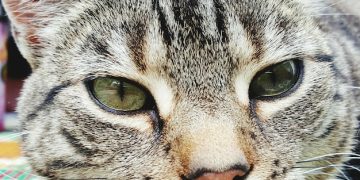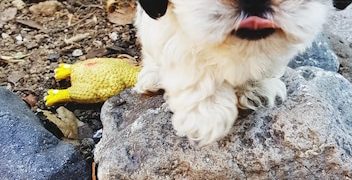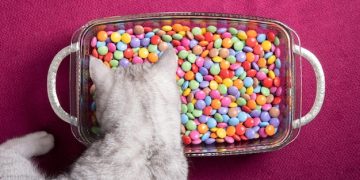Decoding Cat Behavior: Understanding Feline Actions
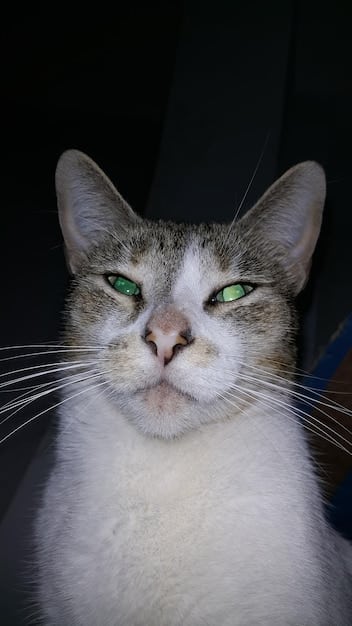
Decoding cat behavior involves understanding a variety of feline actions, from purring and kneading to hissing and tail twitching, each conveying specific emotions and intentions.
Do you ever wonder what your cat is really thinking? **Decoding cat behavior: Understanding common feline actions and what they mean** can unlock a deeper connection with your furry friend, transforming confusing quirks into clear communication signals.
The Basics of Feline Communication
Cats communicate in a variety of ways, and understanding these methods can help you better understand your feline companion. From vocalizations to body language, cats use a combination of cues to express their needs, desires, and emotions.
Learning to interpret these signals strengthens your bond with your cat, promoting a happier and healthier relationship. Let’s look at the ways cats communicate and what they mean.
Vocalizations: More Than Just Meows
Cats use a variety of vocalizations to communicate, each with its own meaning. Understanding these sounds can offer valuable insight into your cat’s state of mind.
- Meowing: Typically used to get your attention, whether it’s for food, play, or simply a cuddle.
- Purring: Often indicates contentment, but can also signal pain or anxiety, acting as a self-soothing mechanism.
- Hissing: A clear warning sign, indicating fear, aggression, or discomfort. It’s essential to give your cat space when they hiss.
- Growling: Another sign of aggression or fear, usually preceding a potential attack.
Beyond these common sounds, cats also chatter, chirp, and trill, often when they’re watching birds or other prey. These sounds express excitement and anticipation.
In summary, vocalizations are one tool cats use to communicate. However, one must always consider the context of the sound to appropriately understand your cat.
Understanding Feline Body Language
A cat’s body language speaks volumes, offering clues to its mood and intentions. Paying attention to posture, tail movements, and ear position can reveal a wealth of information.
By observing these physical cues, you can gain a deeper understanding of what your cat is trying to tell you, even without vocalizations. Let’s consider some key aspects of feline body language.

Posture: Reading the Overall Vibe
A cat’s posture can tell you a lot about how it’s feeling. A relaxed cat will often lie down with its paws tucked underneath, while a tense cat might crouch low to the ground.
An arched back and raised fur indicate defensiveness or fear, while a playful cat might stretch and roll around, inviting interaction.
Tail Talk: Interpreting Tail Signals
The tail is a key indicator of a cat’s emotional state. A vertical tail with a slight curve usually means the cat is happy and approachable. A twitching tail can indicate excitement or agitation, while a tucked tail signals fear or submission.
- Upright Tail: Generally indicates happiness and confidence.
- Twitching Tail: Can signal excitement, annoyance, or agitation, depending on the context.
- Puffed-Up Tail: Indicates fear or aggression, making the cat appear larger and more intimidating.
A swishing tail can mean the cat is focused on something, like prey, or that it’s feeling irritated. Observe the cat’s other cues to accurately interpret the tail’s message.
Overall, posture and tail position can tell you a lot about how a cat is feeling. They represent a key piece to decoding cat behavior.
Why Do Cats Knead? Unraveling the Mystery
Kneading, also known as “making biscuits,” is a common feline behavior that involves rhythmically pushing their paws into a soft surface. It’s a behavior often associated with contentment and comfort.
While the exact reasons behind kneading are debated, several theories attempt to explain this endearing habit. Let’s look at this behavior and the reason behind it.
The Kittenhood Connection
One theory suggests that kneading is a behavior rooted in kittenhood. Kittens knead around their mother’s teats to stimulate milk flow, creating a positive association with comfort and nourishment. As adult cats, they may continue kneading as a way to self-soothe and recreate those early feelings of security.
Marking Territory with Scent
Another theory suggests that kneading serves as a way for cats to mark their territory. Cats have scent glands in their paws, and kneading releases their unique scent onto the surface, signaling ownership to other cats.
- Comfort: Kneading can be a sign of relaxation and contentment.
- Territory Marking: Cats may knead to leave their scent on a particular surface.
- Health Concerns: In some cases, excessive kneading may indicate stress or anxiety.
While kneading is generally a harmless behavior, it’s important to monitor your cat’s kneading habits and consult with a vet if you notice any sudden changes or excessive kneading, as it could indicate underlying stress or discomfort.
Therefore, kneading reflects comfort, potential marking, and sometimes stress that could contribute to health concerns. Consider all contexts when interpreting a cat kneading.
The Enigma of Cat Purring Explained
Purring is often associated with contentment, but it can also indicate other emotions, such as pain or anxiety. Understanding the nuances of purring can help you better gauge your cat’s emotional state.
Why do cats purr, and what do different purrs mean? Let’s delve into the complexities of this unique feline vocalization.
The Mechanics of Purring
The exact mechanisms behind purring are not fully understood, but it’s believed to involve the rapid contraction and relaxation of muscles in the larynx. This creates vibrations that resonate throughout the cat’s body, producing the characteristic purring sound.
While purring is commonly associated with contentment, cats also purr when they’re injured, sick, or stressed. In these cases, purring may serve as a self-soothing mechanism, releasing endorphins that promote healing and reduce pain.
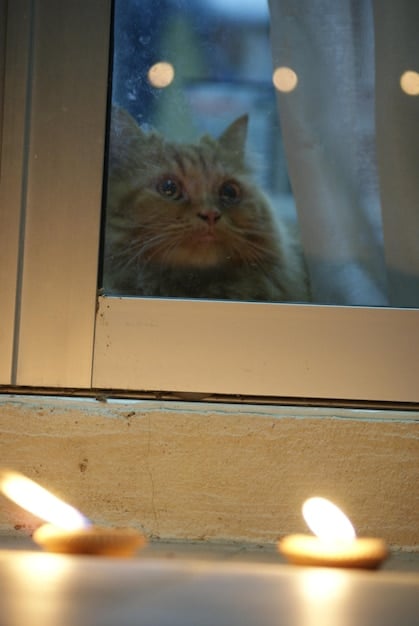
The Healing Power of Purrs
Studies have suggested that the frequency of a cat’s purr, which ranges from 25 to 150 Hertz, can promote bone growth and tissue repair. This may explain why cats purr when they’re injured or recovering from illness.
- Contentment: The most common reason for purring, indicating relaxation and happiness.
- Self-Soothing: Cats may purr when they’re stressed, anxious, or in pain to release endorphins.
- Healing: The frequency of a cat’s purr may promote bone growth and tissue repair.
In summary, purring is a complex and versatile vocalization that can convey a range of emotions and play a role in healing and self-soothing. Pay attention to the context of the purr to accurately interpret its meaning.
Thus, purring can indicate contentment, self-soothing, and even healing.
Decoding Cat Tail Movements
The tail is a powerful communication tool for cats, conveying a range of emotions and intentions. By observing tail movements, you can gain a valuable insight into your cat’s state of mind.
What do different tail positions and movements mean? Let’s explore the language of the feline tail.
The Language of the Tail
An upright tail with a slight curve at the tip usually indicates happiness and confidence. A cat with its tail held high is signaling that it’s friendly and approachable. A twitching tail can mean excitement, annoyance, or agitation, depending on the context.
A puffed-up tail, often accompanied by an arched back and raised fur, indicates fear or aggression. The cat is trying to make itself look larger and more intimidating to ward off potential threats.
When the Tail is Tucked
A tucked tail signals fear, submission, or insecurity. The cat is trying to make itself appear smaller and less threatening. A swishing tail can mean the cat is focused on something, like prey, or that it’s feeling irritated. The speed and intensity of the swishing can indicate the level of agitation.
- Upright Tail: Happiness, confidence, and approachability.
- Twitching Tail: Excitement, annoyance, or agitation.
- Puffed-Up Tail: Fear, aggression, or defensiveness.
- Tucked Tail: Fear, submission, or insecurity.
- Swishing Tail: Focus, irritation, or agitation.
When interpreting tail movements, it’s important to consider the overall context and other body language cues. A combination of signals will provide the most accurate understanding of what your cat is trying to communicate.
Observing tail movements allows you to better interpret how a cat is feeling or reacting to something.
Common Misunderstandings in Cat Behavior
Despite our best efforts, misunderstandings can arise when interpreting cat behavior. Certain actions can be easily misinterpreted, leading to confusion and frustration for both cats and their owners.
From purring to scratching, let’s examine some common feline behaviors that are often misunderstood and how to avoid misinterpreting them.
Purring: Not Always a Sign of Happiness
While purring is often associated with contentment, it’s important to remember that cats also purr when they’re stressed, anxious, or in pain. A purring cat isn’t necessarily a happy cat; it could be trying to self-soothe or signal to you that something is wrong.
Observe other body language cues to accurately interpret the meaning behind a cat’s purr. A combination of signals will provide a more complete picture of their emotional state.
Scratching: Not Just Destructive
Scratching is a natural and necessary behavior for cats. It allows them to maintain their claws, stretch their muscles, and mark their territory. While it may seem destructive, scratching is not done out of spite or malice.
- Purring: Can indicate contentment, stress, anxiety, or pain.
- Scratching: Natural behavior for claw maintenance, stretching, and territory marking.
- Hissing: A warning sign, not necessarily a sign of aggression.
Provide your cat with appropriate scratching posts and surfaces to redirect this behavior away from your furniture. This will satisfy their natural instincts while protecting your belongings.
Hissing is not always an act of aggression. Hissing could signify protecting their territory and warding off threats while also signalling they need space.
| Key Point | Brief Description |
|---|---|
| 😻 Decoding Feline Actions | Understanding feline behavior involves interpreting vocalizations, body language, and unique actions. |
| 🐾 Kneading | Kneading behavior stems from kittenhood, symbolizing comfort and is also a way for cats to mark territory. |
| 🔊 Purring | Purring may indicate contentment, self-soothing, and even healing. |
| 🤸Cat Tail Movements | Tail movements are another key indicator in helping to understand cat behavior. |
Frequently Asked Questions
▼
Cats knead on soft surfaces as a behavior that stems from kittenhood when they would knead around their mother’s teats. This behavior is associated with comfort and relaxation, but can also be considered a scent-marking behavior.
▼
When a cat wags its tail it is usually agitated or irritated. When a cat is relaxed, its tail remains still or sways gently. If the tail is wagging it is best to leave the cat alone.
▼
A cat purrs when it is content, but can also purr when feeling stress or pain. Purring releases endorphins into the body, which is why some cats may purr when they are hurt or anxious about something.
▼
Scratching is a completely normal and healthy behavior for cats that helps to maintain their claws and stretch their muscles. It also acts as a way for them to mark their territory, so it is important to have scratching posts available.
▼
You can tell if your cat is happy if they are relaxed. Some signs of a relaxed cat are a still or swaying tail and calm vocalizations. You can also tell by the cats behavior, or if they are purring while being petted or held.
Conclusion
Understanding your cat’s behavior is key to building a stronger, more loving relationship. By learning to decode their vocalizations, body language, and unique actions, you can better respond to their needs and create a harmonious environment for both of you. Don’t make assumptions; instead, focus on observing and learning to interpret the subtle cues your feline friend is constantly providing.
